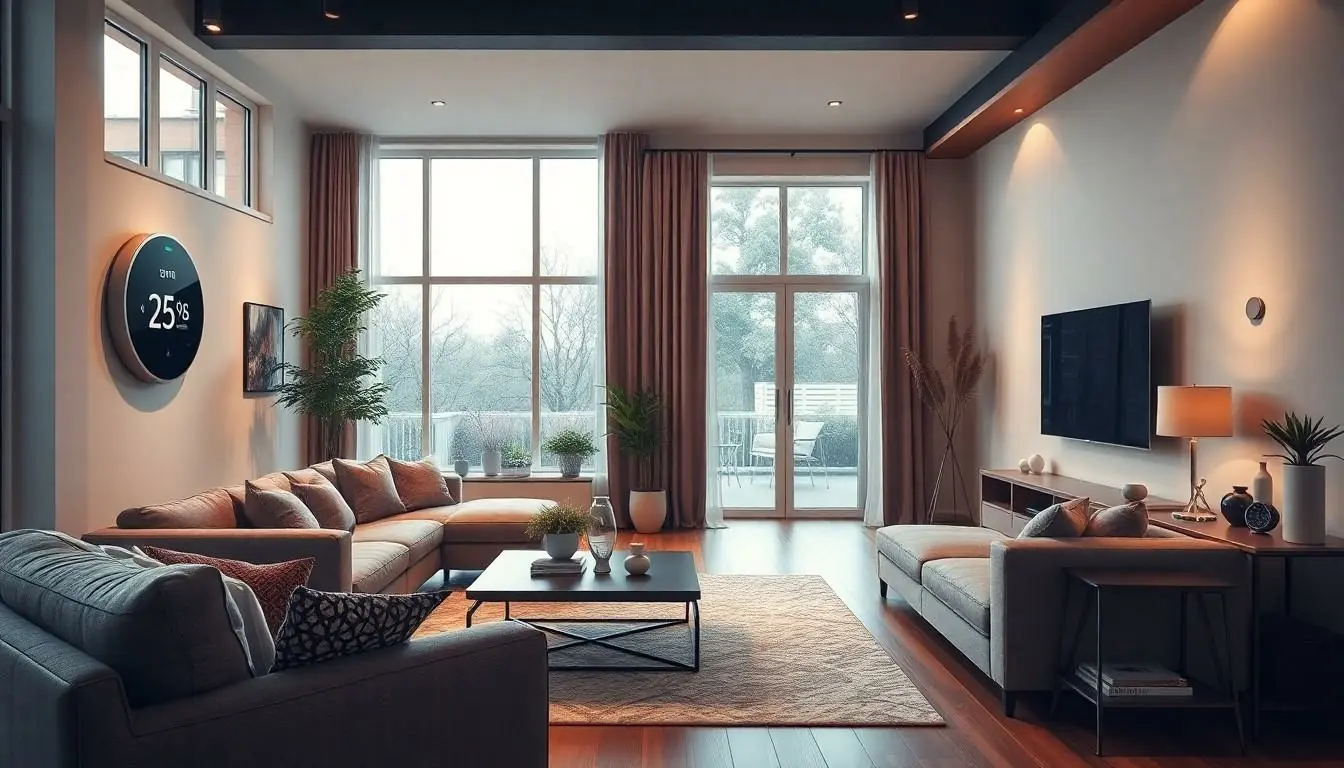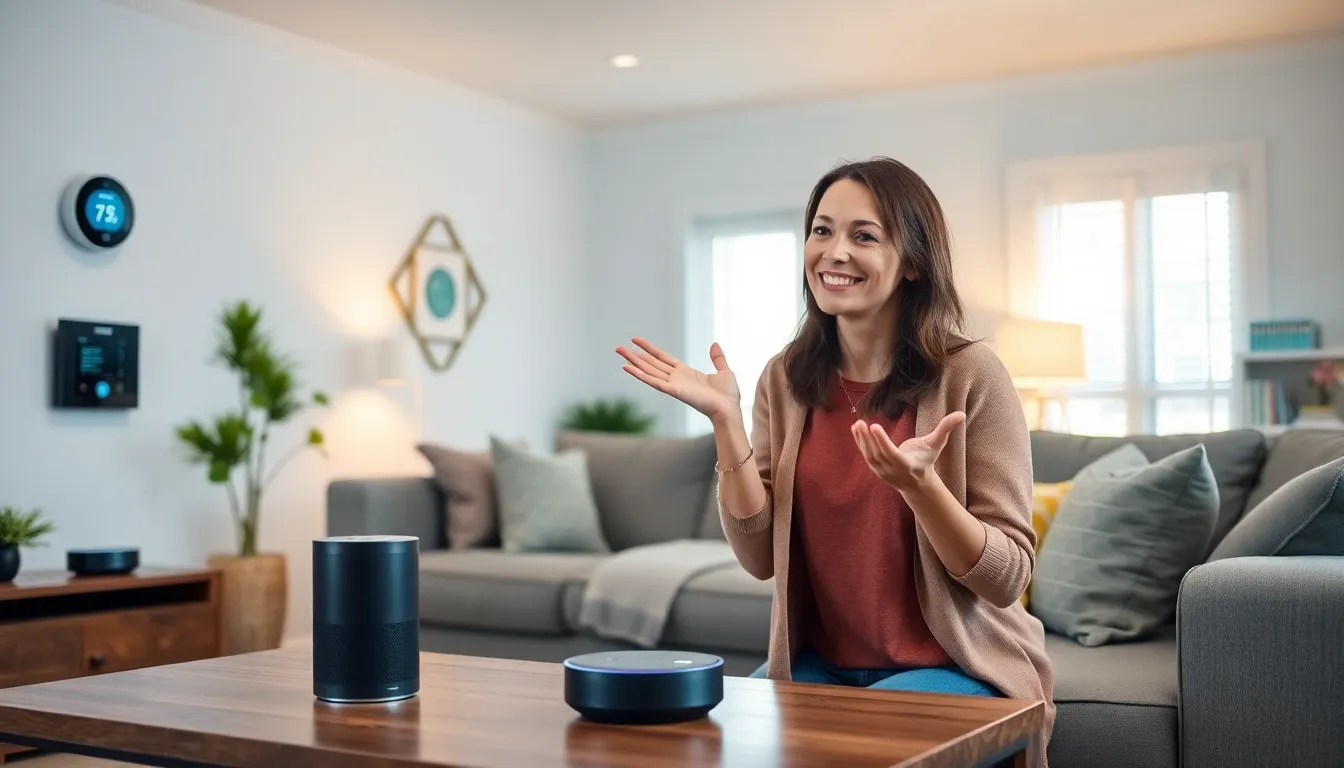Imagine walking into your home and having the lights turn on, the coffee brew, and your favorite playlist start playing—all without lifting a finger. Welcome to the world of IoT home automation, where technology meets convenience in a way that even your cat will be impressed. With smart devices working together seamlessly, your home becomes a haven of efficiency and comfort.
Table of Contents
ToggleOverview of IoT Home Automation
IoT home automation integrates various smart devices for seamless interactions. Devices communicate via the internet, enhancing convenience and efficiency in daily routines. Consider smart thermostats, which adjust temperature settings based on personal preferences.
Lights equipped with smart bulbs can change brightness and color according to the time of day or user commands. Appliances like coffee makers interact with smartphones, allowing users to start brewing remotely. Security cameras offer real-time monitoring, providing peace of mind to homeowners.
Management of these devices occurs through central hubs or applications. These platforms provide user-friendly interfaces, enabling easy control of multiple devices from one location. Users can create schedules for devices, enhancing energy efficiency by ensuring operations align with lifestyle habits.
Intelligent voice assistants, such as Google Assistant or Amazon Alexa, further simplify voice commands for device management. These assistants enable users to perform tasks hands-free, making interactions more intuitive and accessible.
The benefits extend to energy management, as IoT home automation contributes to reduced energy consumption. Smart systems can analyze usage patterns, adjusting operations to optimize performance. Homeowners often experience cost savings on utility bills as a result.
Enhancing comfort and security defines the essence of IoT home automation. The technology continues evolving, promising greater integration and smarter solutions for modern living environments. As advancements unfold, homeowners increasingly recognize the value that these systems provide in their daily lives.
Benefits of IoT Home Automation

IoT home automation offers various advantages that significantly enhance living environments.
Increased Convenience
Smart devices simplify daily activities. From adjusting thermostats to scheduling lights, these systems streamline tasks. Remote access allows users to control devices from anywhere. For example, turning on the coffee maker before arriving home makes mornings easier. Voice commands further enhance usability by allowing hands-free interactions. Beyond just convenience, automation creates a seamless living experience. Users benefit from integrative systems that respond to personal preferences and routines. Customizable settings cater to specific needs, ensuring satisfaction at every turn.
Energy Efficiency
Energy management plays a vital role in IoT home automation. Smart systems monitor usage patterns, helping users identify energy consumption peaks. For instance, adjusting heating during off-peak hours can lead to significant savings. Automated lighting systems ensure lights turn off in empty rooms, reducing unnecessary energy use. Furthermore, smart appliances adapt operations based on real-time data, further minimizing waste. Overall, these strategies result in lower utility bills and an environmentally friendly household. By optimizing energy efficiency, IoT technology not only benefits homeowners financially but also contributes to broader sustainability goals.
Popular IoT Devices for Home Automation
Home automation relies on various IoT devices to enhance convenience and efficiency. These popular devices streamline daily tasks and improve energy management.
Smart Lighting
Smart lighting systems enable users to control brightness and color remotely. Options include LED bulbs compatible with voice assistants like Google Assistant or Amazon Alexa. Many setups allow for scheduling, adjusting lights automatically based on time or activity. Energy efficiency becomes easier to achieve, as these systems utilize less power than traditional bulbs. Some products even offer motion detection features that turn lights on or off based on room occupancy.
Smart Thermostats
Smart thermostats adapt to personal temperature preferences and schedules. They learn user habits over time, ensuring optimal heating and cooling without wasting energy. Sensors detect whether anyone is home, adjusting settings accordingly. Integration with smartphones allows for remote control, enabling climate adjustments while away. Many models provide energy reports, offering insights on usage patterns and suggesting improvements.
Security Cameras
Security cameras play a crucial role in home safety within IoT ecosystems. Many devices provide high-definition video feeds, enabling users to monitor their property in real time. Alerts inform users of unusual activity, ensuring timely response to potential threats. Some cameras include features like night vision and two-way audio for enhanced functionality. Mobile apps simplify access to live streams and recorded footage, ensuring peace of mind from anywhere.
Challenges and Considerations
IoT home automation offers various benefits, yet it presents challenges that require careful consideration.
Security Risks
Security risks represent one of the most significant concerns for IoT home automation systems. Devices connected to the internet may become vulnerable to hacking attempts. Unauthorized access can lead to the manipulation of smart devices or breaches of personal data. Furthermore, a lack of security updates on certain devices can exacerbate these vulnerabilities. Homeowners must implement robust security measures, such as strong passwords and encryption, to safeguard their systems. Regularly updating device firmware helps mitigate potential threats, ensuring that smart home systems remain secure.
Compatibility Issues
Compatibility issues often arise with IoT home automation devices. Different manufacturers may utilize varying protocols, leading to challenges in device integration. Not all devices communicate effectively with central hubs, creating complex setups. Selecting a unified platform can simplify this process, but it may limit the choice of compatible devices. Consumers must research compatibility before purchasing devices to avoid future connectivity problems. Compatible devices enhance functionality, allowing seamless interactions and robust automation capabilities.
Future Trends in IoT Home Automation
Smart home technology continues evolving, with several trends shaping IoT home automation’s future. Increased integration among devices creates a more cohesive user experience. Companies now focus on developing platforms that support a wide range of devices, ensuring interoperability among various manufacturers.
Enhanced artificial intelligence capabilities significantly impact automation systems. They allow smart devices to learn from user behaviors and preferences, resulting in more personalized interactions. Automation systems adapt to individual routines, improving overall efficiency and comfort in the living environment.
Voice recognition technology showcases further advancements in IoT home automation. Consumers find it convenient to control lighting, appliances, and security systems through vocal commands. Marketers predict that voice interfaces will become the primary method for managing smart homes, making interactions more intuitive and accessible.
Data analytics will gain prominence as devices accumulate vast amounts of information. Manufacturers will leverage this data to identify usage patterns, leading to smarter energy management and further cost savings on utility bills. Homeowners will benefit from insights into their consumption habits, allowing for tailored recommendations on optimizing energy use.
Sustainability trends increasingly influence product designs and smart technology solutions. Eco-friendly devices and energy-efficient designs encourage consumers to make environmentally conscious choices. As awareness of climate change grows, demand for sustainable alternatives in IoT home automation is likely to rise.
Cybersecurity measures will also evolve alongside IoT innovations. With the escalation of hacking threats, homeowners require better protection for their smart devices. Enhanced security features, such as advanced encryption and multi-factor authentication, will become standard in new products to safeguard user data.
Overall, these trends reflect a shift towards more sophisticated, efficient, and secure IoT home automation solutions, enhancing homeowners’ living experiences.
IoT home automation is transforming the way people interact with their living spaces. By integrating smart devices, homeowners can enjoy enhanced convenience and energy efficiency. The seamless communication between devices simplifies daily tasks and allows for personalized experiences tailored to individual preferences.
As technology continues to evolve, the future of IoT home automation looks promising. Innovations in artificial intelligence and data analytics will further optimize energy management and enhance user interactions. With a focus on security and sustainability, these advancements will create smarter and safer homes. Embracing IoT home automation not only elevates comfort but also contributes to a more efficient and eco-friendly lifestyle.





